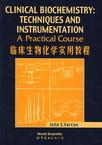临床生物化学实用教程
出版时间:2003-6 出版社:北京世界图书出版公司 作者:J.S.Varcoe
内容概要
本书是一部注重理论和和实践结合的临床生化教程。作者认为亲自动手去做实验会极大地增强人们对分析技术和所采用仪器的理解,因此,本书作者力求覆盖在临床生物化学中使用的主要分析技术和仪器,分析技术主要包括色谱学、光学、电化学、电泳、酶学、免疫学、分子诊断学和其它一些技术,并附以练习帮助学生对于仪器分析应用的理解。要目:分光光度;X光检测法;酶学;原子泄出和吸收;离子选电极;色谱法;薄层色谱法和提取技术;气体色谱法;高性能液态色谱法;电泳法;分子诊断学;免疫学技术和X射线检测法。读者对象:临床生物化学和相关专业的本科生及研究生。
书籍目录
AcknowledgmentsAbbreviations.Chapter 1. Spectrophotometry Photometric Analysis. The Effect of Solvent 1 5 Laws of Radiant Energy Absorption. Lambert's Law 1-6: Beer's Law 1-6; Beer Lambert's Law 1-8, Interrelationship Between Absorbance and Transmittance I 8 Colour and Colorimeters. The Blank. Instrumentation. Sources of Radiant Energy 1-9; Means of Spectral isolation 1 11; Adjustable Diaphragm 1-15; Cuvettes 1-15; Radiant Energy Detectors 1-16; Readout Systems 1-21; A Typical Single Beam Speetrophotometer 1-21; Double Beam lnstruments 1-22; A Typical Double Beam up" Period 1 25; Optimum Spectral Band Width 1-25; Stray Light 1 27;Correction for BackRround Absorption 1-30 Checking Instrument Performance. Wavelength Alignment I 33: Wavelength Repeatability 1-34; Spectral BandWidth 1-34; StrayLight 135:Pbotometric Aecuracy and Linearity 1-35 Exercises. Exercise 1-1: Photometric Accuracy and Linearity. Exercise 1-2: Spectral Band Width. Exercise 1-3: Spectral Characteristics of a Filter. Exercise 1-4: Wavelength Check. Exercise 1-5: Spectral Band Width and Resolution. Exercise 1-6: Cuvette Cut-Off Wavelengths. Exercise 1-7: The Absorption Spectrum of Benzene. Exercise 1-8: The Absorption Spectra of NAD and NADH, Exercise 1-9: Stray Light. Exercise 1-10: Derivative Spectra. Exercise 1-11: The Determination of Serum Calcium. Exercise 1-12: The Determination of Carbon Monoxide in Blood. Exercise 1-13: The Determination of Plasma SaEey[ate. Exercise 1-14: The Determination of Plasma ParacetamobChapter 2. Fluorimetry Fluorescence, Factors Affecting Fluorescence Intensity : Concentration 2-3, Solvent 2 4, Buffers 2-5, pH and lonisation 2-5, Temperature 2-6, Photo-decomposition 2-6, Quenching 2-6 instrumentation, Light Sources 2 8; Sample Containers 2-9; Detectors 2-9; Sensitivity 2-9; An Example of a Spectrofluorimeter 2 10 Exercises Exercise 2-1 : The Effect of Concentration on Fluorescence Intensity. Exercise 2-2 : ]he Effect of Solvent on Fluorescence Intensity. Exercise 2-3 : The Effect of pH on Fluorescence Intensity. Exercise 2-4 : The Effect of Temperature on Fluorescence Intensity. Exercise 2-5 : The Effect of Quenching on Fluorescence intensity. Exercise 2-6 : The Emission Spectrum of NADtt. Exercise 2 7 : The Determination of Thiamine in Urine. Exercise 2-8 : The Determination of Serum Magnesium. Exercise 2 9 : The Determination of Phenylalanine in Plasma. Exercise 2 10 : The Determination of Blood Porphyrins. ReferencesChapter 3.Enzymology. Enzymes. Catalysis 3-1; Classiflcation and Nomenclature 3-2; EnzymeDnits 3 3:Modes of Action 3-4; The Active Site 3-4: Substrate Specificity 3-4; pH3-5; Temperature 3-5; Enzyme Kinetics 3-6; Enzyme Inhibitlon 3-9: Allosteric Enzymes 3-12; Isoenzymes 3-13 Clinical Enzymology. The Diagnostic Use of lsoenzymes 3-17 Enzymes as Reagents. Exercises. Exercise 3-1: The Polarimetric Determhlatlon of tnvertase. Exercise 3-2: The Effect of Temperature on lnvertase Activity. Exercise 3-3: The Effect of pH on [nvertase Activity. Exercise 3-4: The Effect of Substrate on Yeast Alcohol Dehydrogenase Activity, Exercise 3-5 : The Effect of Substrate Concentration on Yeast Alcohol Dehydrogenase Activity. Exercise 3-6 : The Effect of an Inhibitor on Yeast Alcohol Dehydrogenase Activity. Exercise 3-7 : The Determination of Prostatic Acid Phosphatase in Plasma. Exercise 3-8 : The Determination of Plasma Lactate Dehydrogenase and its lsoenzymes, Exercise 3 9 : The Fluorimetric Determination of Alkaline Fhosphatase in Plasma.……Chapter4. Atomic Emission and AbsorptinChapter5. Ion Selective Electrodes.Chapter6. Oxygen and Carbon Dixide Electrodes.Chapter7. Chromatography.Chapter8. Thin Layer Chromatography and Extraction Techniques.Chapter9. Gas Chromatography.Chapter10. High Performance Liquid Chromatography.Chapter11. Electophoresis.Chapter12. Molecular Diagnostics.Chapter13. Immunological and Radioisotope Techniques.Chapter14. Coulometry,Osmometry and RefractometryAppendicesIndex
图书封面
评论、评分、阅读与下载
用户评论 (总计0条)
相关图书
- 中国食品安全报告
- 软件工程卷2
- 文人的风骨
- 现代领导学
- 心理素质养成与训练
- 心理学考点精讲.仿真习题精练与历年真题题集
- 实用骨伤科学
- 实用胸部外科学
- 城市数字化工程(上中下)
- 常见疾病非药物治疗手册
- 常见肝病诊治手册
- WINDOWS XP PROFESSLONAL安装.设置与管理-MCSA/MCSE EAM70-270致胜经典(第二版)
- SharePoint Services由入门到精通
- 精通Windows Server2003
- 消化性溃疡病
- 更多软件需求实际问题解决方案
- 64格导游大师
- 我们的队伍向太阳
- 2003年北京市区县人大代表竞选实录
- 中国石窟雕塑全集 2
- 走出“生之者寡,食之者众”的困境
- 中国城市社区直接选举改革
- 乡村政治若干问题研究
- 中国石窟雕塑全集第1卷:敦煌 (平装)
- 非洲艺术7:埃及等 (平装)
